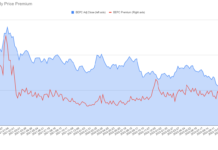I’m not sure whether John Maynard Keynes, the father of Keynesian economics and an ardent proponent of government interventionism during hard economic times, and Rachel Carson, the mother of modern environmentalism and the author whose work is credited for the eventual creation of the EPA, ever met during their lifetimes. But if current voter sentiment holds until November 4, their ideas could soon converge and form the basis of government policy for at least the next four years. Let me explain. First, John Maynard Keynes. There is no doubt that the deliberate and coordinated nationalization of financial services institutions across the West marks a new low for neoconservative economic thinking. This line of thinking holds that government should play as small a role as possible in the economy, and leave spending decisions to individuals and firms. Proponents of this philosophy argue that the best fiscal move a government can ever make is to return money to its citizens and corporations through tax cuts, who will then spend that money most efficiently. The Keynesian approach, on the other hand, is premised on the idea that it is not only OK but even desirable for governments to step in and directly incur large expenditures in difficult times to jump-start the economy. Until the credit crisis hit, the Keynesian view had all but disappeared from Washington, and small and unobtrusive government was all the rage. However, in the wake of the economic and financial havoc wrecked by what many view as too much withdrawal of government from the economy, it appears as though its has become politically-acceptable for American lawmakers to overtly push for a more activist state. What form will this take, according to proponents? In old Keynesian fashion, large-scale infrastructure investments to create jobs and kick-start aggregate demand. While it is not especially surprising to hear academics argue for this form of government intervention, it’s quite something to see Democratic politicians so emboldened by recent polls that they feel they can safely write about it in op-eds. The current crisis, it appears, has cast serious doubts in the minds of a growing number of voters on the ability of the free market to deliver wealth and well being for everyone, thus setting the political stage for a return to a more interventionist state in America. Second, Rachel Carson. Obama’s environmental credentials are strong to be sure. He has remained steadfast in his support of clean energy as a cornerstone of his broader energy policy, even in the face of overwhelming public support for domestic drilling and falling fossil fuel prices. It is therefore no wonder that in cleantech-addicted Silicon Valley, generally a place where big government is seen as a break on innovation and entrepreneurship, a number of high-profile VCs and their employees are supporting Obama. AltEnergyStocks.com officially endorsed Obama last week specifically for his credentials on alternative energy and energy efficiency. While some of Obama’s motivations for being in favor of clean energy have to do with energy independence and economic development, it is fair to say that he is also strongly motivated by his own environmental values and his belief that climate change must be addressed. What does this all mean for investors? As the macro-economic consequences of the credit crisis continue to spread, I expect an Obama victory to result in some form of an activist government strategy to boost employment and the economy. This activist program will revolve around massive expenditures in large-scale infrastructure projects, and if Obama can help it there will likely be an environmental angle to the program. If what politicians are currently saying is a true indication of what they intend to do, rail transportation is likely to be a major beneficiary. In the first of this two-part series on how investors can play the build-out in clean infrastructure, I present four stocks I came across while doing research on this. Besides rail transport, the other major area of infrastructure alt energy investors care about is electricity transmission. Given Obama’s promises on clean energy and the environment, the amount of press the Pickens Plan is receiving, and the state of America’s transmission system, it is not unreasonable to expect that Washington could seize this opportunity to direct massive investments into this area as well. In the second part of this series, I will discuss potential plays on transmission. Stocks For The Clean Infrastructure Build-out, Part 1 – Rail Transport When doing research on this topic, I looked for companies that would benefit from investments in the rail infrastructure network, rather than companies linked to running or manufacturing/maintaining trains and cars. A severe economic downturn coupled with lower gasoline prices would reduce demand for rail transport, so this is not an area I’m particularly bullish on for the next year or so. In the long run, however, I believe that the renaissance of North American rail driven by high energy prices, tighter environmental regulation and an increasingly clogged highway network that’s running out of space to expand, will be a strong theme to watch for alt energy investors. I did not run any numbers or do an extensive amount of due diligence on the firms below, so if you have any information to share please go ahead. Koppers Holdings (KOP). Financial statements here. At upwards of 45%, Koppers holds the largest market share in the North American railway tie business. Railway ties are the wooden beams that support the rails. Koppers also makes utility poles, and could thus benefit from investments in electricity transmission. One interesting thing about Koppers is that it runs a biomass power plant that burns recycled railway ties and utility poles (I found that out while checking the website. They have a video about it). At a PE of around 6.3x last year’s earnings, this stock is trading in cheap territory. LB Foster (FSTR). Financial statements here. LB Foster’s rail division sells rail and other related product
s to a range of industries including passenger and freight railroads, rail transit, ports and others. One interesting feature of this company is that it also recycles and re-sells used rail. This stock is currently trading at a trailing 12-month PE of around 2.2x, which is very cheap by most measures. I haven’t looked closely into this firm so I’m not sure why it would be trading at such a discount to its peers, even in difficult market conditions. Stella Jones (STLJF.PK or SJ.TO). Financial statements here. At about 20%, this company has the second largest market share in the North American railway tie market after Koppers, and it has been an aggressive consolidator of the fragmented treated wood market. The company also has a 70% market share of the Canadian railway tie market, another jurisdiction where the government is weighing the merits of infrastructure spending as a counter-cyclical measure. Stella Jones is also active in wooden utility poles and could benefit from spending programs in electricity transmission. One of the major negatives with this stock is illiquidity: the largest shareholder owns about 62% of shares outstanding, and volumes tend to be extremely light. At a trailing 12-month PE of around 9.8x, Stella Jones is reasonably priced, although increased debt levels recently on the back of five acquisitions in five years could be a concern. Global Railway Industries Limited (GRWIF.PK or GBI.TO). Financial statements here. Most of the company’s business is in the sale of locomotive and other train components. However, it also sells a range of railway track and signal products. This stock is currently trading at around 10x last year’s earnings, so it is the most expensive of the four. DISCLOSURE: Charles Morand does not have a position in any of the stocks listed above. DISCLAIMER: I am not a registered investment advisor. The information and trades that I provide here are for informational purposes only and are not a solicitation to buy or sell any of these securities. Investing involves substantial risk and you should evaluate your own risk levels before you make any investment. Past results are not an indication of future performance. Please take the time to read the full disclaimer here.









Though the Keynesian arguments seem to be coming into play even more in recent years, I still think the hands of approach from government is best in the long run. If looking at immediate effects it may not seem so, but the periods of good economic function which have lasted the longest usually come within a year or two after a hands off approach has been implemented. It takes time, but it is able to last much longer than the more intrusive Keynesian tactics.